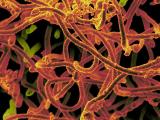Nov 30, 2005 (CIDRAP News) Researchers have found evidence of Ebola virus infection in three African species of bats that are eaten by humans, suggesting that bats may be a natural reservoir of the mysterious virus, according to a report published today in Nature.
Recent Ebola outbreaks in humans have been linked with concurrent outbreaks in chimpanzees and gorillas, says the report by Eric M. Leroy of the Franceville International Center for Medical Research in Gabon and colleagues. But where the deadly virus hides between outbreaks has been a mystery.
To search for it, the researchers trapped small animals near infected gorilla and chimpanzee carcasses just after their discovery during recent Ebola outbreaks in Gabon and the Republic of the Congo. The authors trapped 1,030 animals in all, including 679 bats, and tested them for evidence of Ebola infection.
The investigators found immunoglobulin G (IgG) specific for Ebola in 16 fruit bats of three different species. In addition, polymerase chain reaction (PCR) revealed Ebola virus nucleotide sequences in liver and spleen tissue from 13 other bats of those same species.
The virus itself was not isolated, and the findings suggest that the amount of virus in the tissues was very low, the report says. All three bat species live in regions where human Ebola outbreaks have occurred.
None of the bats that tested positive for Ebola-specific IgG tested positive for the virus by PCR, and none of the PCR-positive bats was IgG-positive, the investigators report. They speculate that the PCR-positive bats were tested too soon after infection to have developed a detectable immune response.
"Although other bat and animal species may also act as Ebola virus reservoirs, insight into the behavioural ecology of the bat species identified here should help to improve protection of the great apes from Ebola virus," the authors write.
They add that because people in the outbreak regions eat fruit bats, education might help prevent people from being infected by exposure to the animals.
The new findings come 2 months after researchers reported evidence that bats may be the natural reservoir for the agent of another relatively new disease: SARS (severe acute respiratory syndrome). In September, two teams of scientists reported discovering that bats in China were hosts for a coronavirus closely related to the SARS coronavirus.
Leroy EM, Kumulungui B, Pourrut X, et al. Fruit bats as reservoirs of Ebola virus. Nature 2005 Dec 1;438:575-6 [Abstract]
See also:
Reports on SARS-like coronavirus in bats:
Proceedings of the National Academy of Science [Abstract]
Science [Abstract]













